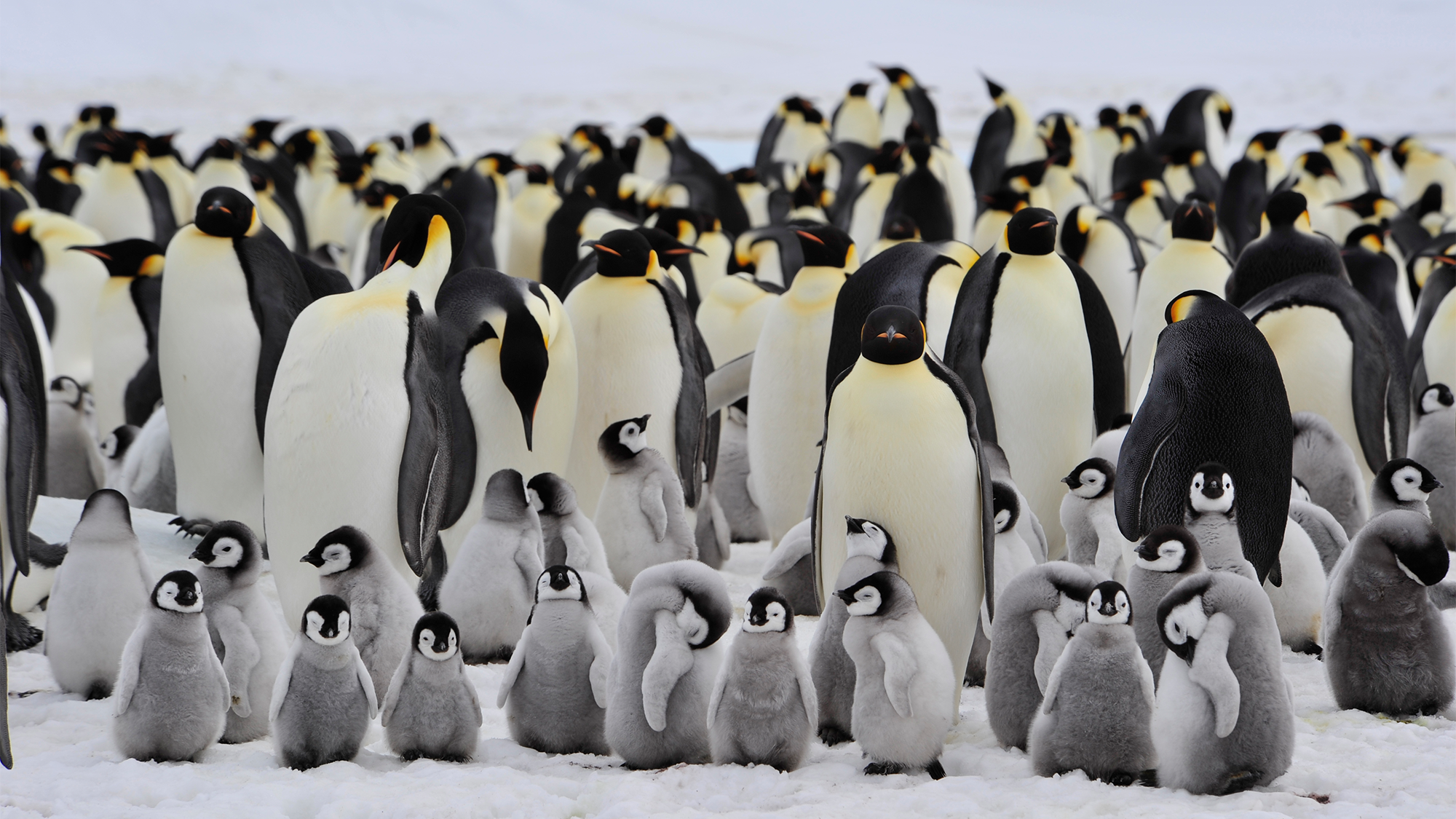

Dark stains on the pristine white ice and snow in Antarctica gave scientists from the British Antarctic Survey the clues they needed to find four previously unknown Emperor penguin breeding sites. The penguins’ guano–aka bird poop–showed up on satellite imagery as a series of dark smudges and allowed researchers to zero in on these new breeding sites. The findings are described in a study published January 20 in the journal Antarctic Science.
[Related: The march of the penguins has a new star: an autonomous robot.]
Colonies of thousands of these large penguins live and breed on the frozen sea ice along the coast of Antarctica. However, rising ocean temperatures due to climate change is melting the ice at a rapid rate and forcing Emperor penguins to relocate to more stable ground. Typically, Emperor penguins breed in sites that are remote and inhospitable to humans, so researchers rely on satellite imagery to find and monitor Emperor penguin colonies and the poop stands out clearly against the white landscape. In 2018, a “super-colony” of about 1.5 million Adélie penguins (751,527 pairs) was discovered by satellite images that showed large amounts of penguin poop.

Finding a ‘lost’ colony
Some known colonies have already moved 18 to 25 miles towards new breeding grounds. In the process, the scientists using satellites discovered the four colonies that had never been recorded. One of these groups includes the Halley Bay colony which the researchers previously thought had vanished. This group has re-established itself near the MacDonald Ice Rumples, which are about 18 miles east of their old breeding sites. There are now a total of 66 known Emperor penguin colonies, according to the British Antarctic Survey.
Researchers used images from the European Commission’s Copernicus Sentinel-2 satellite mission and high resolution images from the 383-mile high Maxar WorldView-3 satellite to confirm the discovery, which comes with some mixed news.
Emperor penguin colonies living in the Earth’s South Pole saw an unprecedented breeding failure when the region saw a total loss of sea ice in 2022. Four out of five Emperor penguin colonies in Antarctica’s Bellingshausen Sea on the western side Antarctica did not see any chicks survive to successfully fledge in the spring of 2022. They are classified as “near threatened” with about 600,000 Emperor penguins remaining on Earth. However, scientists think that nearly all of their remaining colonies will not be viable by the end of this century.
[Related: Emperor penguins suffer ‘unprecedented’ breeding failure as sea ice disappears.]
“These newly identified locations fill in almost all the gaps in the known distribution of these iconic birds,” British Antarctic Survey remote sensing expert and environmental scientist Peter Fretwell said in a statement. “All except one of these colonies are small with less than 1,000 birds, so finding these new colonies makes little difference to the overall population size. In fact, it is overshadowed by the recently reported breeding failures due to the early and fast ice loss.”
Running out of sea ice
Since 2016, the Antarctic has experienced our years with the lowest sea ice in the 45 years that satellites have been monitoring the area. As of August 2023, the sea ice extent was 849,424 lower than it was in 1981. This is equivalent to losing an area of sea ice larger than Greenland.
The strategy of moving to more stable sea ice is becoming increasingly difficult, as the sea ice is affected across the entire region. Record high global air and ocean temperatures like the planet felt in 2023 only will continue to melt more of the ice in the South Pole.

“We spend all this time monitoring these animals and seeing if they can adapt to climate change, but really, in the end, it’s not the penguins that need to adapt, it’s us,” Fretwell told NBC News. “We need to stop our addiction to fossil fuels—not just for penguins, but for all species, even ourselves.”
It is still too early to tell how successful the breeding season will be. The 2022 season that saw such a catastrophic breeding failure was affected by La Niña and change in wind patterns. A switch in weather patterns could help, but it is still unclear.
“Hopefully, this is a one year thing for now and with the weather pattern changing back to El Niño, the sea ice in this location this year and next year will grow back to what it normally is,” Daniel P. Zitterbart, a physicist by training and an Emperor penguin remote sensing expert from Woods Hole Oceanographic Institution, told PopSci in August 2023. Zitterbart was not involved in either study. “But we all know that this year we had the first 6.4 Sigma event, which means that the sea ice in Antarctica is very low.”
